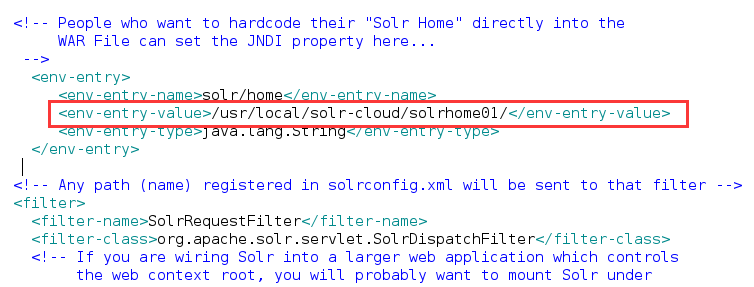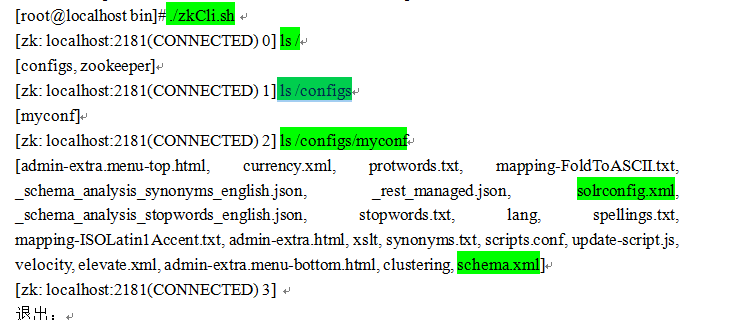又来写博客了,其实对于配置(指任何平台上的配置)而言,一定要仔细仔细再仔细。因为,你可能因为某一个小问题导致后面花上几个小时来排错,排得出来还好,排不出来就全完了。所以,这也是一件很容易让人崩溃的事。话不多说,一条忠告吧,切入主题!
zookeeper集群搭建:
0、上传zookeeper-3.4.6.tar.gz并解压。
1、在/usr/local/下创建solr-cloud目录。
2、复制3份【0】步的zookeeper-3.4.6目录到solr-cloud下,命名为zookeeper01、zookeeper02、zookeeper03。
3、进入【zookeeper0*】目录,创建data目录,并在data目录下新建文件【myid】,里面分别写入1、2、3。
命令:echo 1 >myid
【注意,每个zookeeper都是这样,这里就省略重复的啦】
4、进入【zookeeper01/conf】目录,复制zoo_sample.cfg为zoo.cfg,vim进入编辑zoo.cfg
编辑 dataDir=/usr/local/solr-cloud/zookeeper01/data/
编辑 clientPort=2181
在末尾添加
server.1=192.168.78.133:2881:3881
server.2=192.168.78.133:2882:3882
server.3=192.168.78.133:2883:3883
重复为每个zookeeper进行上述动作,注意目录和端口号得改,剩余端口号为2182、2183,另外注意自己的服务器ip。
至此,zookeeper集群搭建完毕,接下来是solr集群。
solr集群搭建:
首先,若要会搭建solr集群,还是得先会搭建一个单机版的solr。
solr单机版搭建:
0、在/usr/local/下新建solr目录,将一个新解压的【apache-tomcat-7.0.77】(版本随意)复制到solr目录下。
1、上传【solr-4.10.3.tgz.tgz】并解压,进入solr-4.10.3/dist目录,将【solr-4.10.3.war】war包复制到/usr/local/solr/apache-tomcat-7.0.77/webapps下,重命名为solr。接着运行tomcat,观察solr目录是否已经生成。【接着删除那个war包前必须先关闭tomcat,否则会出问题】
2、进入之前解压的solr-4.10.3目录下example/lib/ext/目录,将该目录下所以jar包复制到【大家看下面命令吧】
cp * /usr/local/solr/apache-tomcat-7.0.77/webapps/solr/WEB-INF/lib/
3、创建一个solrhome。/example/solr目录就是一个solrhome。复制此目录到/usr/local/solr/solrhome
4、关联solr及solrhome。需要修改solr工程的web.xml文件

5、启动Tomcat
访问http://192.168.78.133:8080/solr/
至此,单机版搭建成功!
solr集群搭建:
0、复制4份tomcat文件目录到/usr/local/solr-cloud/下,分别命名【tomcat01】-【tomcat04】。
1、将搭建单机版时的工程下的solr目录分别复制进四个webapp下去。
3、为每个solr实例创建一个对应的solrhome。使用单机版的solrhome复制四份。到/usr/local/solr-cloud/下,分别命名【solrhome01】-【solrhome04】
4、修改每个solr工程下的web.xml文件,将地址指定到自己的solrhome目录,完成关联。【注意四份都要设置】

5、配置solrCloud相关的配置。每个solrhome下都有一个solr.xml,把其中的ip及端口号配置好。(请无视图中ip,我找来的图)

6、让zookeeper统一管理配置文件。需要把solrhome/collection1/conf目录上传到zookeeper。上传任意solrhome中的配置文件即可。(此次请注意保证前面三个zookeeper已经启动,否则无法连接!)
./zkcli.sh -zkhost 192.168.78.133:2181,192.168.78.133:2182,192.168.78.133:2183 -cmd upconfig -confdir /usr/local/solr-cloud/solrhome01/collection1/conf -confname myconf
7、测试请先开启每个zookeeper下的服务端,然后再随便找一个客户端目录开启连接指定端口】(bin目录下执行连接指定客户端):
./zkCli.sh -server 192.168.78.133:2183【最最重要的前提是iptables防火墙记得设置2181-2183的ip过滤,否则启动失败】
8、修改tomcat/bin目录下的catalina.sh 文件,关联solr和zookeeper。把此配置添加到配置文件中:
JAVA_OPTS="-DzkHost=192.168.78.133:2181,192.168.78.133:2182,192.168.78.133:2183"

启动每个tomcat实例。要包装zookeeper集群是启动状态。至此,先告一段落吧
PS:更正一下错误,先别着急启动tomcat
先进入自己最先上传solr的解压目录
/home/solr-4.10.3/example/script/cloud-script/
执行:(上传配置文件到zookeeper,一份就好)
./zkcli.sh -zkhost 192.168.78.133:2181,192.168.78.133:2182,192.168.78.133:2183 -cmd upconfig -confdir /usr/local/solr-cloud/solrhome01/collection1/conf -confname myconf
接着随便进入一个zookeeper目录bin下执行
./zkCli.sh -server 192.168.78.133:2183
执行 ls /
执行 ls /configs

接着,再去启动tomcat吧
更新一下错误:
4个tomcat还未更改端口。改conf下的server.xml,给两段代码吧,每个里面改三处端口即可
<?xml version='1.0' encoding='utf-8'?> <!-- Licensed to the Apache Software Foundation (ASF) under one or more contributor license agreements. See the NOTICE file distributed with this work for additional information regarding copyright ownership. The ASF licenses this file to You under the Apache License, Version 2.0 (the "License"); you may not use this file except in compliance with the License. You may obtain a copy of the License at http://www.apache.org/licenses/LICENSE-2.0 Unless required by applicable law or agreed to in writing, software distributed under the License is distributed on an "AS IS" BASIS, WITHOUT WARRANTIES OR CONDITIONS OF ANY KIND, either express or implied. See the License for the specific language governing permissions and limitations under the License. --> <!-- Note: A "Server" is not itself a "Container", so you may not define subcomponents such as "Valves" at this level. Documentation at /docs/config/server.html --> <Server port="8105" shutdown="SHUTDOWN"> <!-- Security listener. Documentation at /docs/config/listeners.html <Listener className="org.apache.catalina.security.SecurityListener" /> --> <!--APR library loader. Documentation at /docs/apr.html --> <Listener className="org.apache.catalina.core.AprLifecycleListener" SSLEngine="on" /> <!--Initialize Jasper prior to webapps are loaded. Documentation at /docs/jasper-howto.html --> <Listener className="org.apache.catalina.core.JasperListener" /> <!-- Prevent memory leaks due to use of particular java/javax APIs--> <Listener className="org.apache.catalina.core.JreMemoryLeakPreventionListener" /> <Listener className="org.apache.catalina.mbeans.GlobalResourcesLifecycleListener" /> <Listener className="org.apache.catalina.core.ThreadLocalLeakPreventionListener" /> <!-- Global JNDI resources Documentation at /docs/jndi-resources-howto.html --> <GlobalNamingResources> <!-- Editable user database that can also be used by UserDatabaseRealm to authenticate users --> <Resource name="UserDatabase" auth="Container" type="org.apache.catalina.UserDatabase" description="User database that can be updated and saved" factory="org.apache.catalina.users.MemoryUserDatabaseFactory" pathname="conf/tomcat-users.xml" /> </GlobalNamingResources> <!-- A "Service" is a collection of one or more "Connectors" that share a single "Container" Note: A "Service" is not itself a "Container", so you may not define subcomponents such as "Valves" at this level. Documentation at /docs/config/service.html --> <Service name="Catalina"> <!--The connectors can use a shared executor, you can define one or more named thread pools--> <!-- <Executor name="tomcatThreadPool" namePrefix="catalina-exec-" maxThreads="150" minSpareThreads="4"/> --> <!-- A "Connector" represents an endpoint by which requests are received and responses are returned. Documentation at : Java HTTP Connector: /docs/config/http.html (blocking & non-blocking) Java AJP Connector: /docs/config/ajp.html APR (HTTP/AJP) Connector: /docs/apr.html Define a non-SSL HTTP/1.1 Connector on port 8080 --> <Connector port="8180" protocol="HTTP/1.1" connectionTimeout="20000" redirectPort="8443" /> <!-- A "Connector" using the shared thread pool--> <!-- <Connector executor="tomcatThreadPool" port="8080" protocol="HTTP/1.1" connectionTimeout="20000" redirectPort="8443" /> --> <!-- Define a SSL HTTP/1.1 Connector on port 8443 This connector uses the JSSE configuration, when using APR, the connector should be using the OpenSSL style configuration described in the APR documentation --> <!-- <Connector port="8443" protocol="HTTP/1.1" SSLEnabled="true" maxThreads="150" scheme="https" secure="true" clientAuth="false" sslProtocol="TLS" /> --> <!-- Define an AJP 1.3 Connector on port 8009 --> <Connector port="8109" protocol="AJP/1.3" redirectPort="8443" /> <!-- An Engine represents the entry point (within Catalina) that processes every request. The Engine implementation for Tomcat stand alone analyzes the HTTP headers included with the request, and passes them on to the appropriate Host (virtual host). Documentation at /docs/config/engine.html --> <!-- You should set jvmRoute to support load-balancing via AJP ie : <Engine name="Catalina" defaultHost="localhost" jvmRoute="jvm1"> --> <Engine name="Catalina" defaultHost="localhost"> <!--For clustering, please take a look at documentation at: /docs/cluster-howto.html (simple how to) /docs/config/cluster.html (reference documentation) --> <!-- <Cluster className="org.apache.catalina.ha.tcp.SimpleTcpCluster"/> --> <!-- Use the LockOutRealm to prevent attempts to guess user passwords via a brute-force attack --> <Realm className="org.apache.catalina.realm.LockOutRealm"> <!-- This Realm uses the UserDatabase configured in the global JNDI resources under the key "UserDatabase". Any edits that are performed against this UserDatabase are immediately available for use by the Realm. --> <Realm className="org.apache.catalina.realm.UserDatabaseRealm" resourceName="UserDatabase"/> </Realm> <Host name="localhost" appBase="webapps" unpackWARs="true" autoDeploy="true"> <!-- SingleSignOn valve, share authentication between web applications Documentation at: /docs/config/valve.html --> <!-- <Valve className="org.apache.catalina.authenticator.SingleSignOn" /> --> <!-- Access log processes all example. Documentation at: /docs/config/valve.html Note: The pattern used is equivalent to using pattern="common" --> <Valve className="org.apache.catalina.valves.AccessLogValve" directory="logs" prefix="localhost_access_log." suffix=".txt" pattern="%h %l %u %t "%r" %s %b" /> </Host> </Engine> </Service> </Server>
<?xml version='1.0' encoding='utf-8'?> <!-- Licensed to the Apache Software Foundation (ASF) under one or more contributor license agreements. See the NOTICE file distributed with this work for additional information regarding copyright ownership. The ASF licenses this file to You under the Apache License, Version 2.0 (the "License"); you may not use this file except in compliance with the License. You may obtain a copy of the License at http://www.apache.org/licenses/LICENSE-2.0 Unless required by applicable law or agreed to in writing, software distributed under the License is distributed on an "AS IS" BASIS, WITHOUT WARRANTIES OR CONDITIONS OF ANY KIND, either express or implied. See the License for the specific language governing permissions and limitations under the License. --> <!-- Note: A "Server" is not itself a "Container", so you may not define subcomponents such as "Valves" at this level. Documentation at /docs/config/server.html --> <Server port="8205" shutdown="SHUTDOWN"> <!-- Security listener. Documentation at /docs/config/listeners.html <Listener className="org.apache.catalina.security.SecurityListener" /> --> <!--APR library loader. Documentation at /docs/apr.html --> <Listener className="org.apache.catalina.core.AprLifecycleListener" SSLEngine="on" /> <!--Initialize Jasper prior to webapps are loaded. Documentation at /docs/jasper-howto.html --> <Listener className="org.apache.catalina.core.JasperListener" /> <!-- Prevent memory leaks due to use of particular java/javax APIs--> <Listener className="org.apache.catalina.core.JreMemoryLeakPreventionListener" /> <Listener className="org.apache.catalina.mbeans.GlobalResourcesLifecycleListener" /> <Listener className="org.apache.catalina.core.ThreadLocalLeakPreventionListener" /> <!-- Global JNDI resources Documentation at /docs/jndi-resources-howto.html --> <GlobalNamingResources> <!-- Editable user database that can also be used by UserDatabaseRealm to authenticate users --> <Resource name="UserDatabase" auth="Container" type="org.apache.catalina.UserDatabase" description="User database that can be updated and saved" factory="org.apache.catalina.users.MemoryUserDatabaseFactory" pathname="conf/tomcat-users.xml" /> </GlobalNamingResources> <!-- A "Service" is a collection of one or more "Connectors" that share a single "Container" Note: A "Service" is not itself a "Container", so you may not define subcomponents such as "Valves" at this level. Documentation at /docs/config/service.html --> <Service name="Catalina"> <!--The connectors can use a shared executor, you can define one or more named thread pools--> <!-- <Executor name="tomcatThreadPool" namePrefix="catalina-exec-" maxThreads="150" minSpareThreads="4"/> --> <!-- A "Connector" represents an endpoint by which requests are received and responses are returned. Documentation at : Java HTTP Connector: /docs/config/http.html (blocking & non-blocking) Java AJP Connector: /docs/config/ajp.html APR (HTTP/AJP) Connector: /docs/apr.html Define a non-SSL HTTP/1.1 Connector on port 8080 --> <Connector port="8280" protocol="HTTP/1.1" connectionTimeout="20000" redirectPort="8443" /> <!-- A "Connector" using the shared thread pool--> <!-- <Connector executor="tomcatThreadPool" port="8080" protocol="HTTP/1.1" connectionTimeout="20000" redirectPort="8443" /> --> <!-- Define a SSL HTTP/1.1 Connector on port 8443 This connector uses the JSSE configuration, when using APR, the connector should be using the OpenSSL style configuration described in the APR documentation --> <!-- <Connector port="8443" protocol="HTTP/1.1" SSLEnabled="true" maxThreads="150" scheme="https" secure="true" clientAuth="false" sslProtocol="TLS" /> --> <!-- Define an AJP 1.3 Connector on port 8009 --> <Connector port="8209" protocol="AJP/1.3" redirectPort="8443" /> <!-- An Engine represents the entry point (within Catalina) that processes every request. The Engine implementation for Tomcat stand alone analyzes the HTTP headers included with the request, and passes them on to the appropriate Host (virtual host). Documentation at /docs/config/engine.html --> <!-- You should set jvmRoute to support load-balancing via AJP ie : <Engine name="Catalina" defaultHost="localhost" jvmRoute="jvm1"> --> <Engine name="Catalina" defaultHost="localhost"> <!--For clustering, please take a look at documentation at: /docs/cluster-howto.html (simple how to) /docs/config/cluster.html (reference documentation) --> <!-- <Cluster className="org.apache.catalina.ha.tcp.SimpleTcpCluster"/> --> <!-- Use the LockOutRealm to prevent attempts to guess user passwords via a brute-force attack --> <Realm className="org.apache.catalina.realm.LockOutRealm"> <!-- This Realm uses the UserDatabase configured in the global JNDI resources under the key "UserDatabase". Any edits that are performed against this UserDatabase are immediately available for use by the Realm. --> <Realm className="org.apache.catalina.realm.UserDatabaseRealm" resourceName="UserDatabase"/> </Realm> <Host name="localhost" appBase="webapps" unpackWARs="true" autoDeploy="true"> <!-- SingleSignOn valve, share authentication between web applications Documentation at: /docs/config/valve.html --> <!-- <Valve className="org.apache.catalina.authenticator.SingleSignOn" /> --> <!-- Access log processes all example. Documentation at: /docs/config/valve.html Note: The pattern used is equivalent to using pattern="common" --> <Valve className="org.apache.catalina.valves.AccessLogValve" directory="logs" prefix="localhost_access_log." suffix=".txt" pattern="%h %l %u %t "%r" %s %b" /> </Host> </Engine> </Service> </Server>